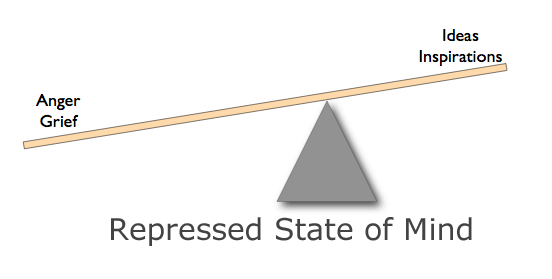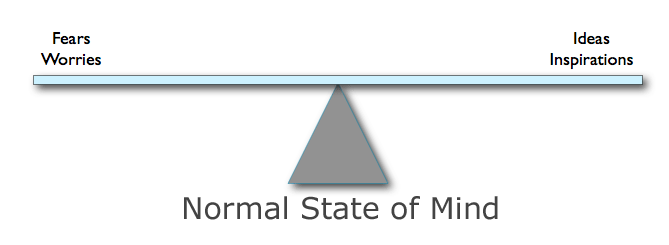The anatomy of a click through
 When we click on a link, we don’t give it a second thought – especially these days when we are presented with 100’s if not 1000’s of potential hyperlinks each day.
When we click on a link, we don’t give it a second thought – especially these days when we are presented with 100’s if not 1000’s of potential hyperlinks each day.
Links nowadays are not limited to those on web sites or in email newsletters. They abound in Twitter tweets and on Facebook Walls.
Knowing how and why people click on one link as opposed to another is of course of interest to the person who posted the link. Indeed understanding how we interact with any text is important for any writer.
Here’s a typical sequence of events:
1. About a second before we are consciously aware of anything, our right brain is continually filtering information before presenting it to our left brain for further processing and analysis. This is known as whole brain filtering.
2. To get past the gatekeeper of the right brain, which works holistically, we have to write content which matches patterns the right brain will light up to. Example might include:
- Keywords – e.g. Video, ebook, iPad, your favourite football team/author/pop group
- Rhymes
- Fun & puns
- Freebies
- Double takes
- e.g. If I had written Triple Take, the right brain would inform the left that there is something new it doesn’t understand that needs analysis
3. Once the left brain is presented the information, it analyses it further with criteria like – is it a con or a spam and is it something to deal with now or park for later? If the former, the motor commands to our arm and hand muscles to click on the link are issued.
4. When we then look at the destination page the whole process is repeated for the opening paragraph – or the image or first few seconds of the audio or video – and then so on for all subsequent content until we meet another link that we follow.
5. So our right brain analyses the whole and our left, the detail.
As for the Google search engine, both have to match otherwise our spam filter kicks in. For example, if we thought we were on a page containing a freebie but it becomes clear the point of the page is to sell you something, you will soon go elsewhere. Long sales pages try and subvert this process by beating the left brain into submission.
“OK,” it says, “I didn’t want to buy anything but it was $5000 and I can get it for only $20 today only.
“The overruled right brain screaming, “They saw you coming.”
6. For best results, the message needs to be completely congruent say from from initial Tweet, to blog title right through the body text to the final call to action.
7. If you have read this far, you will be approaching the call to action – yes, this blog is a soft selling page. Do you feel conned? I hope not as this blog contains some useful free information.
Inspiration in Business
 I am thrilled and extremely honoured to be able to contribute to the 1st issue of Inspire – a new free magazine from of the amazing WeCollaborate community.
I am thrilled and extremely honoured to be able to contribute to the 1st issue of Inspire – a new free magazine from of the amazing WeCollaborate community.
My belief is that there is only a recession if you want there to be one – by bringing inspiration to the workplace, you literally breathe new life into it.
… you can read my article and other erudite thoughts from some amazing writers in the mag here.
How to experience Moments of Light

When you experience a moment of light, it is quite simply magical.
If you happened to have an Magnetic Resonance Imaging [MRI] scanner handy at the time, and you stuck your head in it, you would see every neuron in your brain lighting up as it connects with it’s neighbours. Over 10 billion neurons would light up in harmony shouting “Eureka” at you.
Moments of light like this are more commonly referred to nowadays as light bulb moments. As Archimedes, Newton and Saint Paul could testify though, we experienced them well before the light bulb was invented.
They are a special mode of consciousness where, in less than a second, you see the whole picture. Apparently, Newton intuited the complete theory of gravity in that split second and it took him the rest of his life to tabulate them. They seem like they occur in less than a second because, for that moment, you have jumped outside space and inside time.
It is assumed they are random yet it is possible to enter a special type of meditative state, with your eyes open, where you can experience them on demand. The first step in achieving this state of being is to understand what blocks such moments of light.
Imagine if someone cuts in front of you, into that safe gap you left, on the motorway. You feel affronted. Perhaps, if your life was endangered, you may utter an expletive or even flash your lights at the offender. At that exact moment, certainly what won’t be happening is that you will be having a moment of light. Just by a subtle flip in your thinking though, you could have had an idea for a new novel called Road Rage or a safety device for a car which told the driver the gap was too small to pull into. The issue is that your thoughts are controlling you, not the other way around.
If you are in any kind of heightened negative emotional state, be it anger, sadness, hurt, fear or guilt, light bulb moments are stopped dead in their tracks. Your emotional see-saw gets thrown off balance.
 Even if you had a bright idea, there is just no brain space for it to surface. Any inspiration you might be feeling gets outweighed by heavy emotion. You will have to wait for the extreme emotion to abate.
Even if you had a bright idea, there is just no brain space for it to surface. Any inspiration you might be feeling gets outweighed by heavy emotion. You will have to wait for the extreme emotion to abate.
This is why it’s best not to make a decision or send that email when you are angry. Take a few deep breaths, even wait for 24 hours and you will end up with a better outcome. You may even have a bright idea of how to respond to achieve a much more satisfactory outcome.
For most of the time, and most people, hopefully our brains and minds are running on a more even keel. Instead of rage, anger or grief, perhaps you are just beset with the daily worries of life. From this position, you can begin to enjoy flashes of inspiration and good ideas can get an airing. However, if you are in anyway fearful of the outcome of expressing or executing an idea, you will remain in stasis. You won’t go forward and you won’t go back. Everything will just be fine and dandy and the boat won’t get rocked.

In order to progress from this state of mind, we have to make a leap of faith. We need to see the fears and worries that beset us each day in a different light. Our unconscious mind is the source of such emotions. These fears and worries don’t exist in the real world; they are just inside our heads.
The Fool in the Tarot on the surface can be seen as a reckless figure without a care in the world. In some packs, he is only a couple of steps from walking over the edge of a precipice. He is however enlightened, with his face aligned to the Sun, the source of light. He only appears to be a fool to us as we haven’t reached his state of grace. His emotions are under control. Like the snapping dog at his feet, he knows fears are only there to tell him to pay attention to something. He doesn’t concern himself with them when not appropriate.
If the Fool could speak, his favourite phrase would probably be, “There’s no point worrying about something you don’t have control of.”
So it is not a case of ignoring fears when they arise but paying attention to them only when necessary. If you are worried about something, it is just your unconscious (or gut) mind telling you there’s something you need to address. Once you’ve taken action, move on.
When you make this shift, you become free to work with the light and have unlimited light bulb moments on demand. The see-saw shifts in your favour and you notice something new.
First, to appreciate how to maximize your light bulb moments, we need to look at the dictionary definition of the word ‘moment’. We see that, as well as meaning a moment in time, it is also a force applied at a distance from a central pivot. If you use the same force but with a lever twice as long, you double it’s effectiveness. This of course is nothing new, the architects of Stonehenge and the Great Pyramid knew this.
 When we use it in this see-saw analogy, the length of the lever is proportional to the level of focus in our consciousness and the level of our intent. If we dilute our consciousness by tackling too many things, the lever action will reduce. Channel your efforts and you will reap rewards much easier. With higher intent, the force at the end of the see-saw is amplified further.
When we use it in this see-saw analogy, the length of the lever is proportional to the level of focus in our consciousness and the level of our intent. If we dilute our consciousness by tackling too many things, the lever action will reduce. Channel your efforts and you will reap rewards much easier. With higher intent, the force at the end of the see-saw is amplified further.
So if your aim is to make a million dollars, you will be more effective in that goal if you’ve got a good and worthy use for the money – even if this is purely financial and personal. You don’t have to give it away but just to amass wealth for no purpose is an empty challenge which will just end up with you worrying what to do next. The see-saw will just swing back the other way.
Naturally if everything you bring to your consciousness manifests, you could end up being a busy bee indeed. So it’s fine to flip back from time to time to a balanced state for the see-saw. What is healthier though is to achieve balance using reflection and assessment as opposed to fears and worry.


 When we click on a link, we don’t give it a second thought – especially these days when we are presented with 100’s if not 1000’s of potential hyperlinks each day.
When we click on a link, we don’t give it a second thought – especially these days when we are presented with 100’s if not 1000’s of potential hyperlinks each day.

